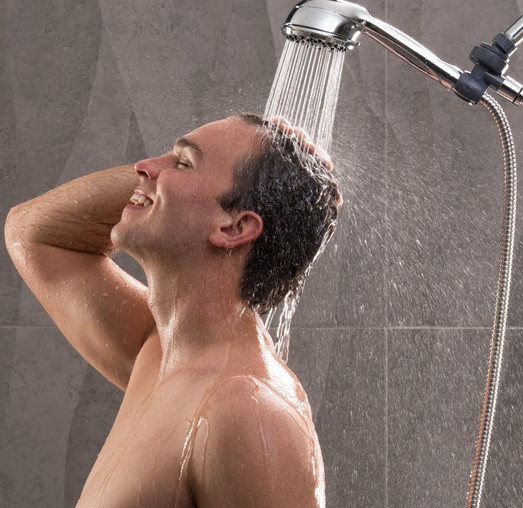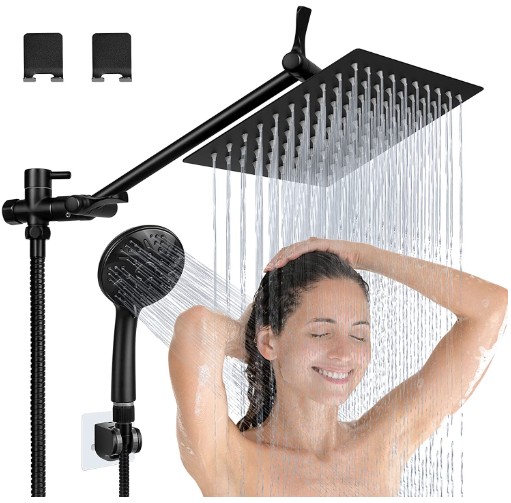A loose shower head holder can be annoying during your daily shower routine because of the inconvenience, water leaks, and potential injury risks. Having insight into the causes of the problem will help you pinpoint the issue and explore viable solutions.
If your shower head keeps falling off, check whether you have loose screws. These are the chief culprits behind the problem. You can also examine high water pressure, a worn-out shower head, and a defective riser rail.
This easy-to-read post delves deeper into why you have a loose shower head holder and how to fix it.

Loose Shower Head Holder (Causes and Fixes)
| Problem | Possible Cause | Recommended Solution | |
| 1. | Loose screws | Changing the orientation of the showerhead repeatedly Mishandling the showerhead Frequent detaching of the showerhead from its holder | Use elastic bands Tighten the screws Replace the showerhead |
| 2. | Worn-out showerhead | Damaged joint between the showerhead and the holder Prolonged use | Replace the showerhead |
| 3. | High water pressure | Faulty pressure regulator Significant height difference between the water source and the house | Replace the pressure regulator |
| 4. | Defective riser rail | Improper installation | Install the riser rail properly |
| 5. | Showerhead too heavy for the holder | Heavy materials | Buy a showerhead that’s compatible with the holder. |
1. Loose Screws
Loose screws are a typical cause of a wobbly shower head, especially if you have an adjustable shower head holder. Different factors culminate in loose screws and loose shower head holders.
When you adjust the height or angle of the shower head holder repeatedly, the screws securing the holder to the bathroom wall or riser rail loosen gradually. Mishandling the shower head, such as using excessive force, also contribute to the mess.
Moreover, frequent pulling and detaching of the shower head from its holder lessen the grip of the screws, compromising the stability of the entire setup. As the screws become increasingly loose, the shower head holder may begin to tilt and cause indescribable inconveniences during your showers.
So, loosening the screws not only affects the shower head holder but can also impact the riser rail supporting the holder. Eventually, the combination of loose screws and an unstable riser rail would make it difficult to maintain a consistent water flow.
Fix
- Start by determining whether the problem stems from the shower head or the shower head holder.
- If it is the shower head, use elastic bands to secure the device to its holder. Duct tape will also suffice here, though it will water down the aesthetic appeal of your fixture.
- Alternatively, get a new showerhead to replace the loose one.
- If the shower head holder is the problem, examine it for missing components.
- Check the riser rail and tighten it if it’s not in position.
- Find the screws and tighten them using a screwdriver.
- Examine the showerhead holder to ensure it’s working as it should.
If the above steps don’t work,
- Remove the riser rail from the wall using pliers or a screwdriver.
- Locate the hole through which your showerhead passes.
- Seal the area around the opening using masking tape.
- Use a pipe or a sprayer to apply expansion foam in the hole.
- Give the expansion foam time to cure, then attach the riser rail back into position.
- Install the showerhead holder and bolt it firmly into place.
2. Worn-out Showerhead
Another cause of a loose showerhead holder is a worn-out showerhead. When your showerhead wears down, it no longer fits snugly into the holder.
The reason for that is the damaged parts create a loose connection between the two components, causing the head to shift, wobble, or even fall off during use. The damaged section is visible, so it shouldn’t catch you by surprise.
Additionally, constant movement and pressure exerted on the worn-out showerhead can result in a compromised joint between the head and the holder. Prolonged use will also have similar consequences on your bathroom fixture.
What follows is a once-tight joint losing its tight grip, leading to a loose showerhead holder. The damaged joint prevents the head from staying in its designated position, resulting in frustrations.
Sadly, you can’t repair a worn-out showerhead, and anything less than a replacement will result in frustration. So, if you notice a damaged joint between your showerhead and holder, address it as soon as possible to avoid further problems.
Fix
- Replace the worn-out showerhead. For instance, BOPai Vacuum Suction Showerhead Holder (View on Amazon) is easy to install, lightweight, reusable, removable, and heavy-duty.

3. High Water Pressure
Besides loose screws and a worn-out showerhead, excess pressure is worth investigating. When the water pressure is too high, it puts weight and strain on the showerhead and its holder, leading to instability.
One possible cause of excess pressure is a defective pressure regulator. The device controls and maintains consistent water pressure through your plumbing system.
However, if it becomes faulty, it allows pressure to surge, placing undue stress on the showerhead holder.
Another factor that may contribute to excess water pressure is the significant elevation difference between your home and the water source. The difference causes gravity to push water to the shower with increased force.
Continuous pressure strains the showerhead holder, resulting in looseness or instability. It is what causes your shower fixture to wobble.
On the contrary, low water pressure is also a telltale sign you have a loose showerhead holder. So, as you troubleshoot excess water pressure, remember that the opposite poses a risk to your showering components.
Fix
- If the height difference between the water source and your house is the issue, Install a pressure-reducing valve to regulate water pressure.
- If the pressure regulator is the problem, hire a certified plumber to examine, repair, or replace the regulator.
- Check and adjust the water pressure if it is lower than recommended.
4. Defective Riser Rail
A shower riser rail is an essential component of a shower setup. It is a vertical bar mounted on the bathroom wall that serves as a support structure; to hold the showerhead holder in place.
When the riser rail malfunctions, it ruins the stability of the entire shower assembly. It fails to provide proper support and proper attachment, leading to the loosening of the showerhead holder.
You can trace the faults to wear and tear, mishandling, and improper installation. They cause weakened joints capable of making your shower device wobble and fall off.
Furthermore, excess water pressure alongside a faulty riser rail will worsen the problem. The intense water flow exerts abnormal stress on the vertical bar attached to the showerhead holder, causing them to shift and become unstable with time.
Fix
- Secure the riser rail back into the bathroom wall.
- Reinstall the showerhead holder.
5. The Showerhead Is Too Heavy For Its Holder
The showerhead being too heavy for the holder adds to the reasons why your showerhead keeps falling off. It often occurs when the showerhead is large or too heavy for the holder to support.
One of the factors that could make the showerhead too heavy is the materials used in manufacturing it. Some holders can only hold lighter showerheads; when faced with a heavier one, they struggle to maintain a secure grip.
If you notice that your showerhead keeps slipping or dropping, it could be a sign the holder is unable to handle the weight.
Furthermore, buying the showerhead and the holder separately can also make your shower device loose because of compatibility issues. The manufacturer may not have designed the holder to support the showerhead.
Fix
- Buy a lighter showerhead that’s compatible with your holder.
- Look for showerheads made of lightweight materials.
- Ensure a proper match between the showerhead and the holder.
- Buy the showerhead together with the holder to avoid incompatibility issues.
When Should You Replace Your Showerhead Holder?
Sometimes, repairing the shower holder could work magic, and your shower will be up and running again. But on other occasions, situations arise when replacing the showerhead holder is the best solution.
The following signs should make you consider replacing the showerhead holder:
1. Low Pressure
Occasionally, you may find a drizzling shower more endearing than a high-pressured one. Here, you won’t have to worry about the water stream or any part of the plumbing system.
However, there are cases where the showerhead holder comes off because of low water pressure. It signifies a worn-out holder begging for replacement.
2. Mold
Mold grows and thrives in damp conditions. The humid conditions in your bathroom give it a conducive environment to spread on the floor, the wall, and even within the shower system.
Fungal growth threatens your household’s health if you don’t control it early enough. One of the ways to prevent its spread is installing metal showerhead holders, which offer incredible resistance to mold, unlike their plastic counterparts.
An example of such a fixture is the All Metal Showerhead Holder, which is mold-resistant and features adjustable components to suit individuals of different heights. It also boasts a universal design that makes it compatible with multiple showerheads.
3. Calcium Sediments
If you detach the showerhead from the rest of the system and examine it, you’ll notice it has a filter that keeps sediments away from the shower water. Calcium sediments are a common phenomenon in municipal waters.
The mineral deposits can build up and block the shower, resulting in low water pressure. When that happens, buy a new showerhead and holder and replace the clogged ones.
4. Showerhead Keeps Dropping
A showerhead dropping off shows you have a loose connection between it and the holder. Another cause could be a damaged joint between the two components.
You can address this by tightening the nuts or replacing the older ones.

5. Water-Dripping Sound
Water dripping is an indication you have leaking problems. If left unaddressed, it inflates your water bills, which is the last thing you want.
If you hear continuous dripping sounds, get a new shower holder.
Note
Experts recommend replacing the showerhead holder every 6 to 8 months. It is a strategy to keep molds away.
Final Remarks On Loose Shower Head Holder
Shower systems are integral features in bathrooms that exude completeness, not to mention refreshing your body before and after a long day. But a loose showerhead holder is a problem that could ruin your shower experience.
Thankfully, this post has highlighted the principal causes of the problem and offered expert solutions to handle them.
Also, Find out,
